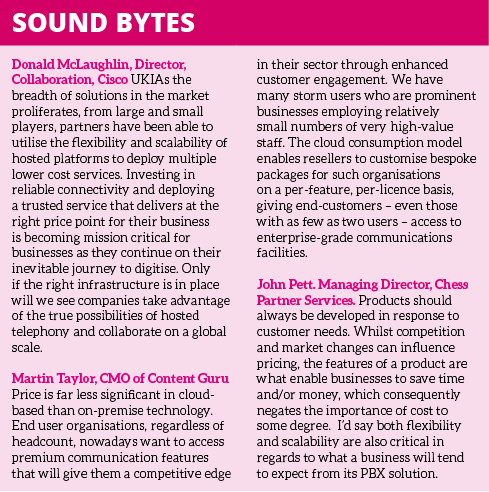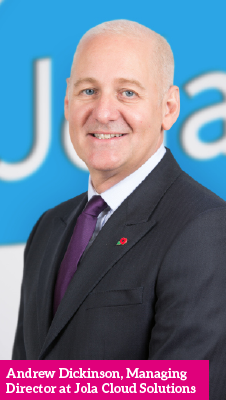
Hosted and Cloud based telephony is a mature market and has been giving providers of CPE solutions a bit of a headache for some time.
As part of an overall communications platform, often in association with unified communications (UCaaS), hosted telephony completes a holistic more rounded solution for firms from SME to Enterprise and an integral element of what is now being referred to and understood to be, a digital transformation.
 We predicted that 2016 would also see the emergence of far greater levels of competition in the platform arena and questioned whether that would increase choice for reseller partners.
We predicted that 2016 would also see the emergence of far greater levels of competition in the platform arena and questioned whether that would increase choice for reseller partners.
For Enterprise organisations we question how CPE based solutions can logically compete with UCaaS in these digital transformations (DX) given that the premise for a DX is basically defined by the words, ‘agile and flexible’.
There is little that is flexible in a CPE solution – scaling up is expensive and time consuming and scaling down has never been on the agenda. Likewise, agility for new demand and re-location is measured in weeks of lead-time and further high cost by ‘traditional’ deployments. Is it in fact time to cease using that traditional moniker? Is not ‘legacy’ a better term for these pieces of tin?
For SME’s, for so long a ‘laggard’ of Enterprise class solutions when it comes to new innovations due to the vendor cost constraints of developing new legacy type solutions there are now instead of hardware costs to consider a range of pay as you go UCaaS solutions available that bring their own ‘softer’ cost considerations such as the skills sets required for implementation.
To gauge how the market is developing however we put a number of questions to channel players to establish the state of the hosted telephony market.
What is the significance of price in this market or is more about flexibility and features?
James Bushell, Head of Product lines at Gamma, says that he encourages resellers to steer away rom talking about price.
 “Once you start down that road you are only going in one direction. Instead we recommend that resellers focus on the value add of the overall deal in terms of bundled services such as the handsets and minutes in order to differentiate the offering. In this way, particularly if the reseller includes the access, you can lock in the end user with a longer term, end-to-end contract.
“Once you start down that road you are only going in one direction. Instead we recommend that resellers focus on the value add of the overall deal in terms of bundled services such as the handsets and minutes in order to differentiate the offering. In this way, particularly if the reseller includes the access, you can lock in the end user with a longer term, end-to-end contract.
Many of our resellers go further by wrapping in other services such as consultancy and support.”
Enzo Viscito, Managing Director of Inclarity, likens the hosted telephony/ UCaaS market to the airline industry.
“You buy a seat on an aeroplane. The price changes by the day and seems random. When you’ve bought your ticket, you find out that you can’t take luggage, you have to pay extra tax and your seat isn’t guaranteed. So what have you paid for? A possibility that you might get to where you want to be?
When buyers decide to buy hosted telephony they want to know exactly what they will get, they don’t want hidden extras and they expect great service.
According to Frost & Sullivan’s latest report on the hosted telephony and UC market, customers are buying more services but they are applying much greater scrutiny to service quality and reliability. Driving hosted telephony adoption isn’t about price, flexibility or features. It is about a delivering a service that is as reliable as the dial tone. This may not be the most exciting comment to make in an industry publication but it is the MOST important from a buyer’s perspective and it still isn’t being delivered. A missed call costs a small business £1200 on average. Businesses are still missing calls because the service they receive isn’t robust enough.”
Steve Tutt, Director of Product Marketing at VanillaIP, argues that if you are in a competitive situation with the exact same product then you can only differentiate by discounting or adding value with professional services.
 “That is a sub-optimal situation on both counts because giving margin away is not ideal and trying to differentiate on ‘soft’ factors is very subjective. VanillaIP, as a BroadSoft service provider, is no different to resellers in this respect. We have to differentiate as well to give our resellers an edge in terms of features and automation.
“That is a sub-optimal situation on both counts because giving margin away is not ideal and trying to differentiate on ‘soft’ factors is very subjective. VanillaIP, as a BroadSoft service provider, is no different to resellers in this respect. We have to differentiate as well to give our resellers an edge in terms of features and automation.
One stabilising factor for pricing has been new market entrants with a direct sales model and fixed pricing. Looking at our own reseller’s bundles and the market as a whole I would say there has been a slight upward pricing trend, albeit with more services bundled in rather than as separate line items. As the market matures customers are not seeing all cloud solutions as the same and are starting to understand the value proposition. We are certainly not seeing the freeware £2/month options from eight years ago.
One challenge we all have is that our solutions are getting more and more sophisticated, which is a good thing, but also means that it’s crucial to be able to build packages that suit your target market. For the sub 10 seat space, for example, less is often more. Mobility is vital alongside Hosted PBX but it’s less likely to be a full UCaaS environment. The important thing is to be able to productise the service in a way that the customers can totally understand it and identify with it and then easily purchase it.”
“Given the large number of packages and prices offered in today’s Hosted and Cloud Telephony market it is not surprising that price is a factor,” says Daniel Burke, Product Manager at Exponential-e.
 “However, the wide price range reflects the wide service range offered from different platforms. At one end of the spectrum there are integrated platforms and clients offering a comprehensive set of unified communication functions integrated to IT infrastructure aimed at increasing employee’s productivity and flexibility. At the other end, there are open source platforms with open source clients (or no clients) offering a more cost effective but perhaps less seamless user experience.
“However, the wide price range reflects the wide service range offered from different platforms. At one end of the spectrum there are integrated platforms and clients offering a comprehensive set of unified communication functions integrated to IT infrastructure aimed at increasing employee’s productivity and flexibility. At the other end, there are open source platforms with open source clients (or no clients) offering a more cost effective but perhaps less seamless user experience.
This creates a lot of choice for customers who need to decide what their current and future business needs are and what a new communications solution must meet.”
TP-LINK’s Senior VAR Account Manager UK Andy Woolhead says price is still very much an issue, but so is ease of installation and on-going maintenance.
“While SoHo businesses may be niche, don’t underestimate their complexity, either in the services they provide, or increasingly, the kinds of communications and project management tools required. More and more are also using freelancers and remote working to deliver projects that require specialist expertise. All these people have to be able to communicate cheaply, effectively and be able to count on reliable communications.”
According to Dr Stuart Marsden, Managing Director of MyPhones.com, while the importance of flexibility and good customer service remain, with more and more platform providers in the market, price is increasingly becoming the major determining factor.
“We are seeing this demonstrated in a number of ways. Many customers are now coming to the end of one of the three-year agreements typical of some platform providers, and with the knowledge they’ve gained over that period are starting to shop around for cheaper alternatives.
The free handsets that formed part of those three-year agreements still work fine, and the offer of another new free handset is not sufficient incentive to hold the customer, which is one of the reasons why we find we are now supporting more than 80 different models of handset on our Altos platform.
Customers today, whether that is resellers or end-users, want to pay only for the services they actually use and want the ability to supplement the core services they receive with features from other providers to create packages that exactly meet their needs. Price, along with contractual flexibilities, are factors that can either assist or deter customers from achieving their objectives.
So, what we mean by ‘flexibility’ is also changing. Today, flexibility is also about interoperability, the ability of your hosted platform to integrate with other platforms, whether these are email platforms, billing platforms, CRM systems, telepresence providers etc.”
 “Businesses also want the ‘biggest bang for their buck’ and that is why we continue to build additional functionality around our solutions,” according to Alex Tebbs, Director at VIA.
“Businesses also want the ‘biggest bang for their buck’ and that is why we continue to build additional functionality around our solutions,” according to Alex Tebbs, Director at VIA.
“Our unique management portal allows organisations to monitor usage trends as well as employee productivity and associated costs from calls. We have also invested heavily in a call routing solution to provide additional value. It is about having the flexibility to meet the requirements of each individual business.
There is a perception that businesses will get access to a more feature-rich solution if they deploy ‘onsite’ but that is not the case. As we run a multi-tenant platform we are constantly developing features for certain customers and then rolling them out to everyone else as a bonus.”
Has the connectivity issue disappeared?
It’s an emphatic no from Enzo Viscito at Inclarity, “We still come across organisations that have been sold cloud telephony solutions for 100’s (and in one instance 1000’s) of users off the back of a 25MB broadband circuit. What an own goal!”
On the other hand, James Bushell at Gamma says “Absolutely. This issue has disappeared in a number of ways and areas. We’ve seen broadband get better and better in terms of robustness, bandwidth and we all have a better understanding how routers work and how we can support them.
Going on in the background to improve service is BT dynamic line management. This recognises that copper attenuates differently and allows networks to adjust throughputs to produce a smoother service.
Today 50% of Gamma voice enabled circuits also support internet as well. This shows how far broadband has come and when you add in more affordable Ethernet with high SLAs it represents great news for resellers.
At the end of 2015 Gamma had 142,000 hosted seats and 260,000 SIP channels. If there were something wrong with what we were doing I think we’d know about it.”
Robin Hayman, Marketing and Product Director at SpliceCom, says that connectivity is still the key to delivering a great voice service, be it in the cloud, on-premise or as a hybrid of the two.
“A private delivery that never has to touch the internet is best practice, but with GEA, EFM and Fibre Ethernet all offering quality of service for voice there are now a myriad of competitively priced options over which a great voice service can be delivered.
Unfortunately there is a race to the bottom for the hosted voice, in terms of price-per-seat, meaning that corners have to be cut somewhere. Lower cost DSL services are usually ‘bundled’ with the overall hosted offer, resulting in voice quality being compromised, as there’s no QoS available. The same holds true for FTTC. If that’s the case then you have to designate a trunk as ‘voice only’, taking us back to the pre-voice & data integration days. But you still run the risk of contention with other less time-sensitive data once a call leaves the building. This is the area where IP Telephony is still getting a bad name and with the three year term coming to an end for many of the early hosted adopters we’re seeing them search for an alternative, whilst wanting to retain the phones they’ve been using. Moving ex-hosted customers onto private cloud, hybrid, or even back to on-premise voice solution has turned into lucrative business for SpliceCom.”
Daniel Burke, Product Manager at Exponential-e says that although raw connection speeds have increased over the last few years, the challenges of business communication with often unsuitable connectivity remain.
“Users’ expectations for fast, fluid and immersive communication wherever they are places greater demands on the infrastructure to provide high quality connectivity at all times. For example, users expect to use their PC for unified communication over the office Wi-Fi, but that means the data-heavy LAN traffic can now affect users’ voice calls. As a result, the bog-standard office Wi-Fi becomes a problem when an important call is distorted. There can be problems out of the four walls of the office too should a third party Wi-Fi router in a local coffee shop causes VoIP calls to be blocked.
So rather than the ‘connectivity issue’ disappearing, its scope has actually expanded. We now require a high-speed, low-latency, dedicated bandwidth WAN connection, and greater control in the LAN when in ‘off-site’ locations.”
“Not entirely,” says Andrew Dickinson, Managing Director at Jola Cloud Solutions, “FTTC has really helped but still doesn’t reach around 40% of businesses. ADSL2+ is better than its predecessors but with limited upstream speeds you have to be careful with how many simultaneous calls you are trying to support.
The availability of business grade care levels on broadband has really helped and we would advise this upgrade on all circuits running critical applications. We still recommend a dedicated circuit for hosted voice although many end users will mix voice and data on FTTC when they are only trying to run one or two simultaneous calls.
EoFTTC has not been the success we anticipated, probably because FTTC is so good, core networks are not congested and EoFTTC is usually three times the price of FTTC. Smaller ISPs are still struggling with the huge demand fluctuations caused by FTTC and consequently traffic shaping, congestion and packet loss are common.
The larger ISPs have invested in massive interconnects and don’t suffer from these issues. It’s definitely worth seeking these out as they are usually only a few pounds more expensive and will save you a lot in customer satisfaction and support costs. There is high demand for hosted from sub-20 seat businesses and most SMEs this size cannot justify a leased line, although prices continue to fall as more secondary carriers enter the market.”
Jonathan Rodwell, Founder and CEO of 500, says “No!”
“Buyers are still struggling to buy connectivity effectively. They have difficulty justifying the cost of a high capacity, resilient infrastructure and they are still struggling with SIP!”
How practical is it for a reseller to partner with two or more providers? For example, Skype, Broadsoft and or Genband. (Just as PBX resellers used to have several systems in their portfolio)
Robin Hayman at SpliceCom says that if PBXs were sold on features and functionality then hosted telephony is sold on price.
“That being the case there’s absolutely no need for resellers to have more than one hosted offer in their bag – there’s basically only two platforms available anyway, which means that the only differentiator is the look and feel of the admin portal.
What Resellers do need, however, is to cover all the bases and that means being in a position to offer a voice solution that matches the prospects IT strategy; public Cloud, private Cloud, on-premise or a hybrid. Offering hosted when the prospect runs an on-site datacentre is just a case of trying to fit a round peg in a square-hole – it’s just not right. To allow resellers to address as broad a range of market opportunities they should ensure that they are partnering with a provider who can cover all four scenarios – or as many as possible – ideally with common features and benefits across all offers, to avoid confusion at the point of sale.”
Steve Tutt, Director of Product Marketing at VanillaIP says it doesn’t make sense to have competing products in the reseller portfolio that totally overlap, each solution needs to add value.
“Perhaps you could have a hosted PBX service and a hosted call centre service. Having two hosted suppliers to spread your risk with one supplier might have been an option for some resellers 7 or 8 years ago when there were still some stability issues and many resellers were not profitable. Those are no longer concerns.”
James Bushell at Gamma, “For me, the issue of multiple hosted telephony suppliers is about why would the reseller want to load themselves up with overheads. Even if you have suppliers with the same platform the service surround is very different. It’s do-able but you’d have to be careful with choice of supplier and need a great deal of automation to make it work. I could however see an application where you took the best of hosted telephony and the best of collaborative working from say Skype for Business and integrated them. That would be interesting.”
Karl Alderton, Managing Director at Comms Supply says that whilst many PBX resellers marketed themselves as supplying systems from a range of vendors, in his experience most had one preferred solution.
“I think the same is true when it comes to hosted telephony but I believe resellers should have at least two partners because no one solution will have all the answers/features the customer may require. Of course, offering more than one solution means that reseller support teams need to understand multiple products. This is where the channel provider should come in: ensuring that their partners get the training and support they need.”
Reseller Comment:
Jonathan Marsden, Sales Director of Leeds based The Technology Group, says that the combination of price and flexibility is absolutely key for us in seizing a competitive advantage.
“For a long time conventionally there has usually been a compromise in one area in that it was impossible to tick all the boxes. However since developing solutions centred around 3CX, it has allowed us to price commercially more attractive, yet genuinely with a better product, that’s easy to use, and that just works! I really do not think we would have even half of the success rate on our opportunities if we had stuck to traditional off-the-shelf hosted solutions, or proprietary PBX systems.
When it comes to partners we find that choice is key. Some VoIP providers offer free / bundled minutes, some have better international offerings; some even provide automated TPS prevention. We like to place the bulk of our business with one or two key providers so as to build strong relationships, and drive forward pricing, yet keeping everyone on their toes. A couple of specialist SIP trunk providers with key features give us the solution edge in certain scenarios using 3CX to perform flexible CLI, or international number presentation, that would not have been achievable with ISDN or conventional hosted.”
